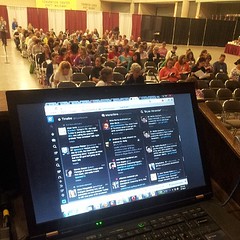
Speaker: Bryan Alexander
NITLE does a lot of research for liberal arts undergraduate type schools. One of the things that he does is publish a monthly newsletter covering trends in higher education, which may be worth paying some attention to (Future Trends). He is not a librarian, but he is a library fanboy.
What is mobile computing doing to the world, and what will it do in the future?
Things have changed rapidly in recent years. We’ve gone from needing telephone rooms at hotels to having phones in every pocket. The icon for computing has gone from desktop to laptop to anything/nothing — computing is all around us in many forms now. The PC is still a useful tool, but there are now so many other devices to do so many other things.
Smartphones are everywhere now, in many forms. We use them for content delivery and capture, and to interact with others through social tools. Over half of Americans now have a smartphone, with less than 10% remaining who have no cell phone, according to Pew. The mobile phone is now the primary communication device for the world. Think about this when you are developing publishing platforms.
The success of the Kindle laid the groundwork for the iPad. Netbooks/laptops now range in size and function.
Clickers are used extensively in the classroom, with great success. They can be used for feedback as well as prompting discussion. They are slowly shifting to using phones instead of separate devices.
Smartpens capture written content digitally as you write them, and you can record audio at the same time. One professor annotates notes on scripts while his students perform, and then provides them with the audio.
Marker-based augmented reality fumbled for a while in the US, but is starting to pick up in popularity. Now that more people have smartphones, QR codes are more prevalent.
The mouse and keyboard have been around since the 1960s, and they are being dramatically impacted by recent changes in technology. Touch screens (i.e. iPad), handhelds (i.e. WII), and nothing (i.e. Kinect).
If the federal government is using it, it is no longer bleeding edge. Ebooks have been around for a long time, in all sorts of formats. Some of the advantages of ebooks include ease of correcting errors, flexible presentation (i.e. font size), and a faster publication cycle. Some disadvantages include DRM, cost, and distribution by libraries.
Gaming has had a huge impact in the past few years. The median age of gamers is 35 or so. The industry size is comparable to music, and has impacts on hardware, software, interfaces, and other industries. There is a large and growing diversity of platforms, topics, genres, niches, and players.
Mobile devices let us make more microcontent (photo, video clip, text file), which leads to the problem of archiving all this stuff. These devices allow us to cover the world with a secondary layer of information. We love connecting with people, and rather than separating us, technology has allowed us to do that even more (except when we focus on our devices more than the people in front of us).
We’re now in a world of information on demand, although it’s not universal. Coverage is spreading, and the gaps are getting smaller.
When it comes to technology, Americans are either utopian or dystopian in our reactions. We’re not living in a middle ground very often. There are some things we don’t understand about our devices, such as multitasking and how that impacts our brain. There is also a generational divide, with our children being more immersed in technology than we are, and having different norms about using devices in social and professional settings.
The ARIS engine allows academics to build games with learning outcomes.
Augmented reality takes data and pins it down to the real world. It’s the inverse of virtual reality. Libraries are going to be the AR engine of the future. Some examples of AR include museum tours, GPS navigators, and location services (Yelp, Foursqure). Beyond that, there are applications that provide data overlaying images of what you point your phone at, such as real estate information and annotations. Google Goggles tries to provide information about objects based on images taken by a mobile device. You could have a virtual art gallery physically tied to a spot, but only displayed when viewed with an app on your phone.
Imagine what the world will be like transformed by the technology he’s been talking about.
1. Phantom Learning: Schools are rare and less needed. The number of people physically enrolled in schools has gone down. Learning on demand is now the thing. Institutions exist to supplement content (adjuncts), and libraries are the media production sites. Students are used to online classes, and un-augmented locations are weird.
II. Open World: Open content is the norm and is very web-centric. Global conversations increase, with more access and more creativity. Print publishers are nearly gone, authorship is mysterious, tons of malware, and privacy is fictitious. The internet has always been open and has never been about money. Identities have always been fictional.
III. Silo World: Most information is experienced in vertical stacks. Open content is almost like public access TV. Intellectual property intensifies, and campuses reorganize around the silos. Students identify with brands and think of “open” as radical and old-fashioned.
